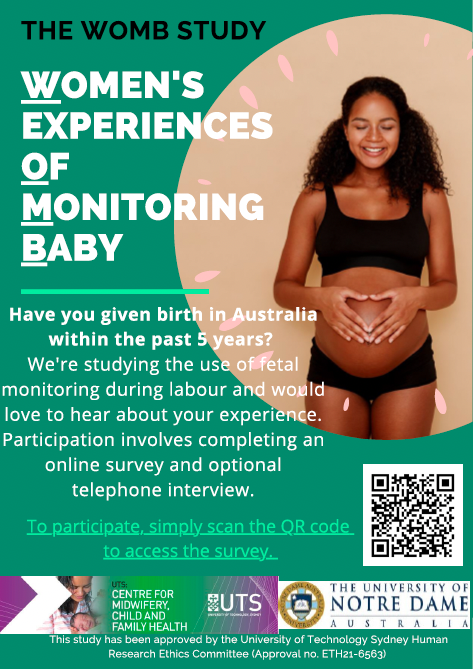Dr. Kate Levett, PhD, is a member of the Science of Birth cluster, a Senior Research Fellow at the National School of Medicine, University of Notre Dame in Australia (UNDA), and an adjunct fellow at the Collective for Midwifery, Child and Family Health, University of Technology Sydney (UTS). A focus of Dr. Levett’s research is the impact of fetal monitoring on women’s labor and birth experiences.
Her study was conducted in collaboration with colleagues including A/Prof Deborah Fox and Dr Vanessa Scarf, at the Collective for Midwifery, Child and Family Health, at the University of Technology Sydney. Their recently published Australian national survey found that most women didn’t know they had any choices about how fetal monitoring was conducted in labor. Most received continuous electronic monitoring with wired transducers, despite being considered at low risk of complications, for which handheld intermittent monitoring would be recommended for use by national guidelines. In Australia, wireless (telemetry) technology has been available for more than 2 decades, but uptake and use by hospitals is still low. In this study, having wired monitoring was strongly associated with induction of labour, higher use of pharmacological pain management such as epidurals, and with having a C-section.
Wireless or handheld methods of monitoring were linked to increased use of non-pharmacological strategies for labour, such as acupressure, water immersion and having freedom of movement. This form of monitoring was also associated with increased rates of vaginal birth. Women who had wired monitoring without epidural, were still more likely to experience unplanned (intrapartum) C-sections. Wired monitoring was reported as the least comfortable option and more than 70% said they wouldn’t choose it again, with women feeing that it negatively impacted on their labour experience.Many women noted that caregivers appeared to focus more on the monitor than on the mother, highlighting the need for more mother-centered monitoring approaches, with methods of monitoring that facilitate women’s mobility, autonomy and sense of control. Find additional resources about this study below:
1. https://www.sciencedirect.com/science/article/pii/S187151922400297X
2. https://www.researchsquare.com/article/rs-4604217/v1
3. https://www.womenandbirth.org/article/S1871-5192(24)00146-X/fulltext
